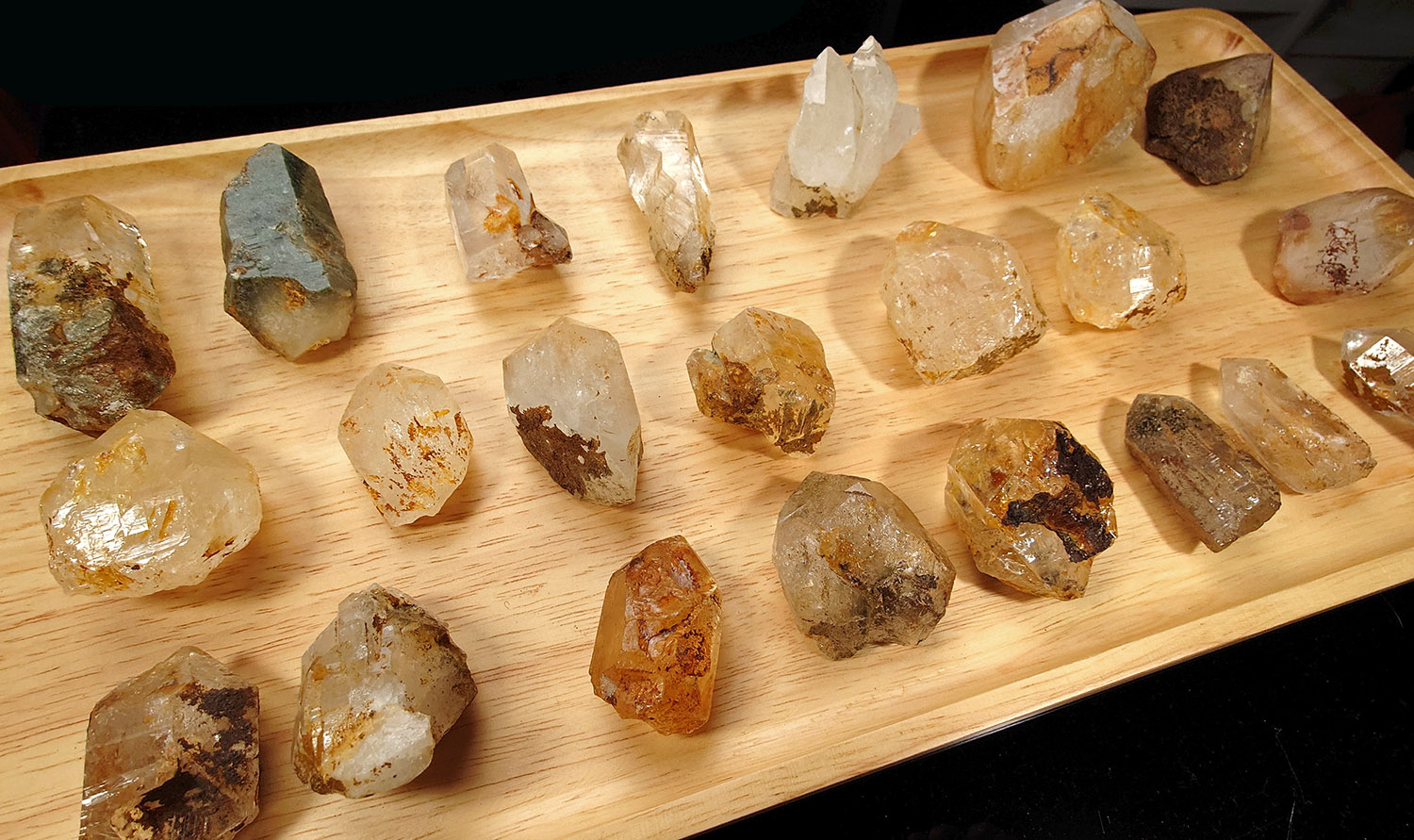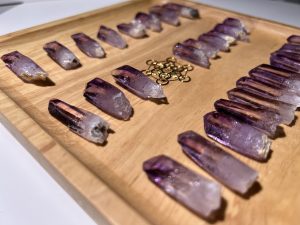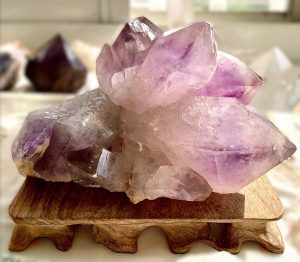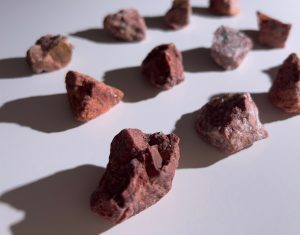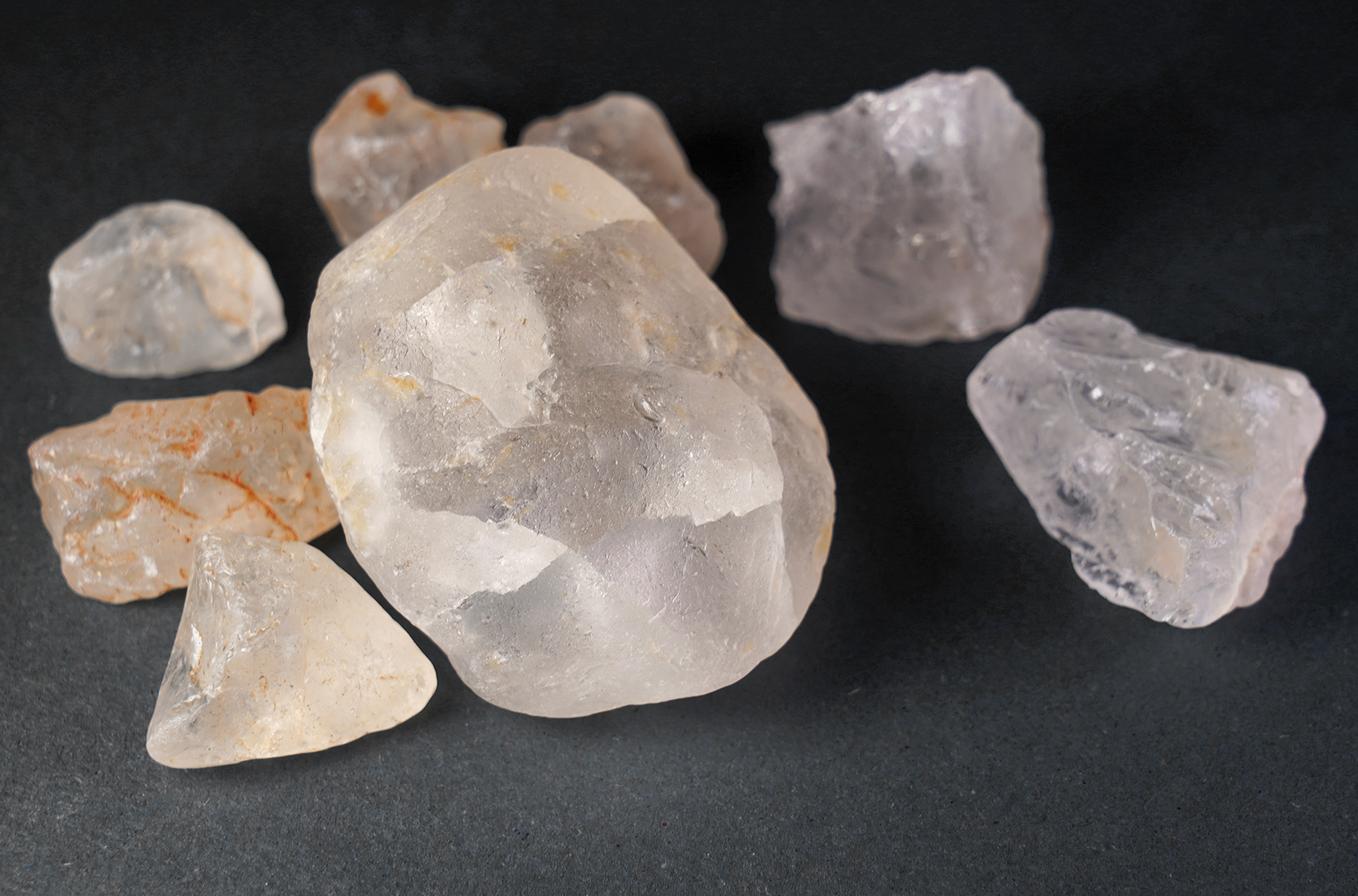Content navigation
High frequency crystals from the Himalayas
The crystals produced in and near the Himalayas have very evolved vibrations. Robert Simmons also introduced some Himalayan white crystal pillars from Nepal last year. His description of the feelings also mentioned their enlightenment and high light-bearing feeling (we sell For Himalayan crystals, we obtain them ourselves from intermediate miners in the mining area. Because Robert is located in the United States, the price he set is very high, and we have geographical convenience in obtaining Himalayan crystals, which can reduce some costs).
Himalayan quartz is primarily found in Pakistan, India, Tibet, and Nepal, which corresponds to the entire region spanned by the Himalayan mountain range on the map. The Himalayan quartz from each of these areas has its own unique characteristics. Recently, India has focused on the mass production of high-clarity quartz, with some specimens featuring surface inclusions of Anatase, or coexisting with Brookite, Rutile, Clinochlore (commonly known as Green Phantom), and other minerals. Pakistan and Nepal, like India, also produce high-clarity quartz at higher altitudes, but in smaller quantities. Additionally, Nepal often produces smoky Himalayan quartz.
Tibet is the most unique. The Himalayan crystals here vibrate at a very ancient high frequency. Most of them are not pure and have mineral damage. Some are full of yellow cortex. Although they are not favored by the mainstream market, you can feel the energy. People, regardless of appearance constraints, can feel that they are humming an ancient frequency that is very difficult to resist.
In principle, Himalayan quartz from these regions will generally have varying degrees of co-occurrence with other minerals such as Anatase, Brookite, Rutile, Clinochlore, and others. Regardless, there are always different levels of clarity and quality. The descriptions above are merely a reference to the current market conditions for the most part.
PS. Rutile, the crystals are mostly columnar or needle-shaped, and a few are cone-shaped or equiaxed. There are often growth stripes parallel to the long axis on the surface of columnar crystals, while needle-shaped crystals are often wrapped in transparent crystals, commonly known as hair crystals. The main component is titanium dioxide, and often contains small amounts of iron, niobium and other ingredients. In nature, those with pure quality are transparent and colorless. If they contain impurities, they will show other colors. Among them, dark red or brown red are the most common, and yellow or black are quite rare (later, the black silver titanium on the crystal market was also found to contain iron. Rutile, maybe this is rare?). There are three main polymorphs of titanium dioxide, namely rutile, brookite and anatase. Rutile is widely distributed, while brookite and anatase are relatively rare.
The higher the altitude in the Himalayas, the more likely it is that the Himalayan crystals produced will have high transparency and high brightness, because this extremely transparent body requires purer water quality and environment, and high altitudes provide such an environment. Because it is more difficult to mine at high altitudes, Himalayan crystals of this quality are very expensive and are said to be among the collections of professional buyers around the world.
In addition to the high-clarity quality found at higher altitudes, some different altitudes and regions may feature more mineral inclusions, such as the previously mentioned Anatase, Brookite, Rutile, Clinochlore, or minerals containing iron. These inclusions result in the golden-skinned Himalayan quartz, which also vibrates with the frequency of a golden healer.
Himalayan Crystal Mining
In the production areas of Pakistan and India, due to the lack of faith, most crystals are mined by blasting mountains. However, in Tibet, when collecting Tibetan Himalayan crystals, my Chinese friend also received a "warning text message" from the Tibetans. ”, roughly speaking, because of Tibetan people’s thousands of years of Tibetan Buddhist belief, and China’s ban on large-scale mining with machinery, Tibetan Himalayan crystals are all knocked down by Tibetans with their bare hands and simple tools, because the Himalayas are Their holy mountain is sacred and inviolable. They all obtain Tibetan Himalayan crystals with a pious and grateful heart, so they also urge us to own and sell them with the same cherished heart. Although I am not sure about the situation in Nepal, But I believe that with the same level of religious piety in Nepal, it should not be far from the situation in Tibet.
Since Himalayan crystals in Tibet cannot be mined by blasting mountains, it is conceivable that most of the crystals that can be obtained manually are crystal mines that grow on the surface of mountains. Therefore, you will find that Tibetan crystals have many symbiotic rocks or golden colors. There are even many defects in the cortex. This is related to the location and method of mining, but I think this is a way that respects nature and the Himalayas more. It is quite worthy of respect. Even if most of them are not clean in appearance, their frequency is still very high. A noble and quite unique piece of Himalayan crystal.
Of course, Tibetan Himalayan crystals will also be clear and transparent in high-altitude areas. The clear transparency seen so far is not as high as in other production areas, but because of what I just mentioned, this is not a crystal that explodes inside the mountain, but is on the surface of the mountain. The crystals obtained, in other words, I think there are definitely crystals with extremely high purity in the Tibetan Himalayas, but most of them are left in the mountains at high altitudes, and they continue to protect the entire holy mountain of Tibetan Buddhism, which is also a kind of beauty. of karma.
In addition, most Himalayan crystals obtained from Tibet are usually not pickled, so they retain more of the appearance of a rocky loess symbiotic surface.
Characteristic identification of Himalayan crystals
Because Himalayan crystal is a well-known type, some people have once sold it on the market as crystal from other origins, because they can get a better price; the general way to identify it is to observe any facet of the crystal cylinder. , whether there are horizontal and vertical lines like a circuit board, this is a surface feature of most Himalayan crystals, mainly because they are related to phosphorite (this is what the predecessor said, specifically whether it is phosphorite requires professional Knowledge, anyway, it is some kind of ore containing iron element or iron compound) symbiotically grown together. After mining, the edges of the crystal pillars will leave traces of such horizontal and vertical lines symbiosis.
Some crystals from non-Himalayan areas also have this characteristic of horizontal and vertical lines, and even some crystals from the Himalayan area, but the horizontal and vertical lines are not obvious. Therefore, the lines on the surface are only general rules and cannot be used as the only feature to identify the origin. Therefore, it is recommended to start from the visible ones. Obtain Himalayan crystals from trusted mining sources or manufacturers, and you will not get other crystals from non-Himalayan origins.
Tibetan Himalayan Crystal
Returning to the theme of this chapter, the Himalayan crystals in Tibet, in addition to the relationship between the collection area and the method, are less highly translucent (of course there are still some areas where more translucent ones can be collected), many of them are also golden yellow. The color is mainly due to their symbiotic relationship with iron-related minerals. Some of their golden yellow or orange-red color comes from the thin layer of iron oxide on the surface. Under appropriate lighting, some will show a beautiful colorful rainbow luster. This is true. Their different energy characteristics are added, giving most of them the qualities of golden healers.
Some crystals have internal inclusions of Rutile, commonly referred to as "Rutilated Quartz" or "Golden Hair Quartz." (For more information on Rutile, which is primarily composed of titanium dioxide, you can refer to the previous PS note. Additionally, other minerals can also form Rutilated Quartz, but in this context, Rutile is identified based on information provided by the mining source.)
The Himalayan crystals in this area collectively hum a very ancient tune and frequency. Compared with the Himalayan crystals in other areas, this is a very unique difference. This is also related to the ancient snow mountain inheritance and Tibetan Buddhism where they grow. Holy places have an inseparable relationship and fate.
In addition to this ancient tune, they, like other crystals located in the Himalayas, vibrate a certain frequency of the Atlantis civilization, helping us to integrate the possibilities of a new transformation that we are now collectively moving towards.
Tibetan Himalayan crystals can quickly resonate with the area above the eyebrow chakra, and quickly reach agreement with our material body and energy level. We will feel that we are integrated with the crystals. I just meditated and felt that I was holding it in my hand. The crystals in it seemed to be non-existent and integrated into my body and energy field. The concepts they conveyed made me feel their very positive effects on our cellular level, helping us to readjust the uncoordinated original frequency. .
They are similar to the Pakistan Skeletal Fenster Elestial Quartz. In my experience, some of them are partners that worked with us during the time of Atlantis, while others served as guardians of altars or as crystal gems on the pillars of temples. However, I feel that the ancient frequency they chant carries an energy from an even more primordial era. It is a vital force that forms a part of our life essence, and our cells need this vibration to help us restore our true nature.
In addition, the fact that they are produced in the holy land of Tibet also means that they are closely connected with all tantra traditions in this snow-capped mountain sanctuary. The ancient frequency they hum should also be part of this inheritance.
Holding the golden leather Tibetan Himalayan crystal in my hand, it quickly activated the energy field of the entire light body. The scope of action was around the subtle energy body closest to our senses. I felt a circular energy field. It quickly reached harmony with my energy field. In almost less than a minute, I felt that the surroundings calmed down, slowed down, and relaxed. I was surprised that this high-frequency crystal actually brought a calm and gentle feeling. .
Compared with the white Himalayan crystal, the effect of the golden Tibetan Himalayan crystal is not concentrated on the upper three chakras. It feels systemic and has powerful healing properties. Although it is systemic, its color also strengthens the targeting. For the resonance of the solar plexus, the white crystal acts on a more cellular level, while the golden one acts on the subtle body level of cells, closer to the non-material energy field. Overall, I feel that they can release many disharmonious energies. Energy helps our body and subtle body achieve a certain degree of harmonious balance.
The Himalayan crystals produced in Tibet mainly come from the Himalayan Mountains area of Shannan City. Recently, crystals said to come from Kailash have also appeared on the market. Some miners refer to the above crystals collectively as Tibetan crystals or Tibetan crystals, while others refer to Kailash as It is also called Himalayan crystal. However, Kailash is located in the Gangdese Mountains and is not the current Himalayan Mountains (the Gangdese Mountains are located to the north and parallel to the Himalayas). However, due to their proximity, the characteristics of the crystals may be similar. , representatives also share the same growth environment and appearance characteristics. If they are all called Himalayan crystals, it is not accurate but understandable. After all, these mountains may have been in the same realm countless centuries ago. After the earth's crust changed, even if they had different names, they still maintained the same environment and energy frequency. As for the names, they were named by humans. Of course, if we introduce it in the future, we will clearly indicate it.
Additional postscript:I contacted my trustworthy Chinese miner friend, and he told me that the crystals currently produced in Tibet are all from Shannan, Kailash and the Ngari region where they are located. There is no crystal output. I cannot go there to confirm in person. , but I will specifically contact my friends to ask because I also have doubts in my heart. Kailash is a very precious sacred mountain, although it also faces the development of tourism industry and the excavation of metal mines with economic value (copper, lead, zinc, etc.) and other questions, but it is true that I have not heard of crystal mining in the relevant information. I am currently observing and seeing if there is more reliable information in the future.
Extra: How to Meet Your Tibetan Himalayan Crystal
If we want to meet the crystal minerals that are truly destined for us, we must cultivate and put aside the human-defined concepts of "beauty, transparency, crystal integrity, etc." Only then can we sincerely feel the energy they truly convey without It will be affected and filtered by our thinking and belief system, so that we can more accurately and efficiently meet old friends who are truly destined for you and can support you. There are many very masters and elder-level crystals that are now incomplete or inconsistent in appearance. From the secular point of view, this is a protective mechanism for them, allowing those who only focus on appearance and collection value to bypass them, so that they have a better chance of meeting the people they really want to serve. Of course, this also has a price aspect. Considering that the price of high-quality crystals with collectible value is usually very high, master-level crystals will be incarnated in a suitable appearance according to the capabilities of their service recipients, in a way that meets the payment requirements of the service recipients.
This is not to say that you can’t choose high-quality and high-priced crystals, no, but you have to put all this aside and feel it with your heart. Your exclusive crystals will appear one after another, and I believe they will all be affordable to you. price appears.

